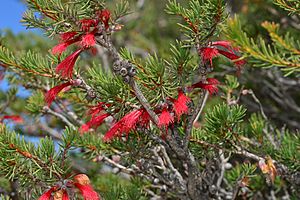Calothamnus brevifolius facts for kids
Calothamnus brevifolius is a special kind of plant. It belongs to the myrtle family, called Myrtaceae. You can only find this plant in the southwest part of Western Australia. It's a small, bushy shrub. It has many branches and leaves that are almost round and pointy. In summer, it shows off beautiful red flowers. Scientists sometimes call it Melaleuca hawkeswoodii.
Quick facts for kids Calothamnus brevifolius |
|
|---|---|
 |
|
| Calothamnus brevifolius in the Charles Gardner Nature Reserve | |
| Conservation status | |
| Scientific classification | |
| Genus: |
Calothamnus
|
| Species: |
brevifolius
|
| Synonyms | |
|
Melaleuca hawkeswoodii Craven & R.D.Edwards |
|
Contents
What Does Calothamnus brevifolius Look Like?
Calothamnus brevifolius is a small shrub. It spreads out and has many branches. It can grow up to about 0.5 meters (1.6 feet) tall. Older stems have thick bark. The plant is also glabrous, which means it has no hairs and feels smooth.
Its leaves are mostly found on the younger branches. They are about 7 to 15 millimeters (0.3 to 0.6 inches) long. They are also very thin, about 0.5 to 0.8 millimeters (0.02 to 0.03 inches) wide. The leaves are almost round and end in a sharp point.
Flowers and Fruits
The flowers of Calothamnus brevifolius are dark pink. They grow in small, thick groups of 1 to 5 flowers around the stem. You usually see them on the younger branches. The petals are thin like paper and are about 5 to 6 millimeters (0.2 inches) long.
The stamens, which are the parts that make pollen, are grouped together. They look a bit like claws. Each group has 15 to 20 stamens. This plant flowers in January and February. After the flowers, it grows woody fruits. These fruits are like small, round capsules, about 1.5 to 2 millimeters (0.06 to 0.08 inches) wide.
How Was Calothamnus brevifolius Named?
The plant Calothamnus brevifolius was first officially described in 1984. A scientist named Trevor Hawkeswood found a sample of it. He found it on a roadside about 11 kilometers (6.8 miles) east of Piawaning.
The second part of its scientific name, brevifolius, tells us something about the plant. It comes from Latin words. Brevi means "short" and folius means "leaved". So, brevifolius means "short-leaved". This name describes the plant's short leaves.
Where Does Calothamnus brevifolius Grow?
Calothamnus brevifolius is only found in certain areas of Western Australia. These areas include the districts of Piawaning, Cunderdin, Corrigin, and Marchagee. These places are part of special natural regions like the Avon Wheatbelt, Geraldton Sandplains, and Mallee.
This plant usually grows in sandy soil or soil mixed with clay, called loam. It often grows near other plants. These include Xylomelum angustifolium, Banksia prionotes, Melaleuca acuminata, or Thryptomene prolifera.
Is Calothamnus brevifolius Protected?
The Western Australian government's Department of Parks and Wildlife keeps track of plants like this. They have listed Calothamnus brevifolius as "Priority 4". This means the plant is rare or almost threatened. It needs to be watched and protected to make sure it doesn't disappear.


